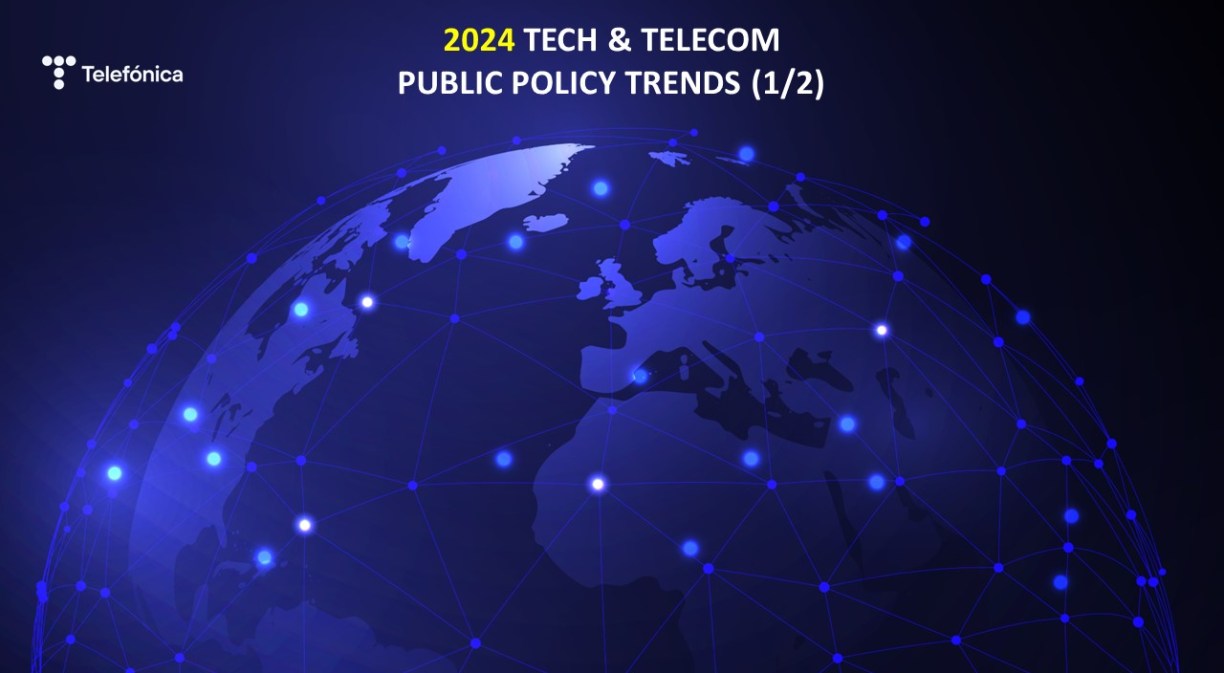This post covers the first 5 top tech & telecom policy trends out of the top 10 identified trends for 2024. The next 5 trends can be read in the second post.
Our first blog post in 2023 was about Chat GPT and how to approach policy for this new, then little-known technological advance. Over the course of the year, the focus on generative artificial intelligence has been on the rise. And it will continue to be a trend into 2024.
The year 2024 will be a record-breaking election year, with more than one in two of the world’s voters going to the polls, including elections in Europe, the US, Brazil, Mexico, India, and Indonesia. And it can lead to a change of context.
In a changing, polarised world, public policy is taking on a new dimension, as we outlined in our Top Policy Trends for 2023. Understanding our environment and taking action to address the challenges is essential, whether it is to improve strategies for economic and business growth, resilience, digital inclusion, or environmental sustainability.
How will technology, policy and regulation shape the year? Let’s find out the first 5 Top Tech & Telecom Policy Trends for 2024.
Artificial intelligence: consolidating the growth and policy approach
In 2023, there was hardly a more discussed policy topic in technology than generative artificial intelligence. The EU AI Act, a landmark regulation agreed in Europe and expected to be published in the first quarter of 2024, could set a future global standard. But it’s still early to say, and it will enter into force in 2026. Worldwide different agreements have been reached to advance the governance of Artificial Intelligence, whether through guidelines or through principles and codes of conduct, such as the Hiroshima process, the Biden Executive Order, or the Bletchley declaration.
In 2024, companies and policymakers will be concerned about a number of issues related to AI, including: how quickly to deploy the technology; which business models, use cases and new devices (e.g. glasses with AI); the impact in society and workforce and how to tackle the challenges; the potential misuse of AI in creation of misleading content, elections or cybercrime or through unintentional bias; the effective allocation of responsibilities along the value chain for AI safety and citizens rights; AI copyright concerns and AI privacy concerns; the governance models and companies’ adherence to codes of conduct or private AI self-regulation, all which will depend on public-private dialogue; the pursuit of success of regulatory or innovation sandboxes; the race for AI between regions and companies becoming a race for data, computing power and energy and concerns about competition issues and the concentration of market power.
We cannot afford these AI systems to be controlled by a handful of companies
New European institutional cycle, single market, and the challenge of competitiveness and strategic autonomy
2024 is a crucial year for Europe to take decisive steps towards long-term competitiveness and open strategic autonomy. This has been the top priority of the Spanish presidency of the Council of the EU that the Belgian presidency will continue to pursue in 2024.
The European Commission (EC) will start a new cycle, with elections of the EU Parliament in June and a new EC. The firm aim is to consolidate a strong, economically competitive, digital and green, single market. The report on the state of the single market commissioned by the EC from Enrico Letta, President of the Jacques Delors Institute and due in March, together with the Mario Draghi’s report on competitiveness, expected in June, will provide guidance.
To move forward, Europe needs to create the business case for investment and innovation “made in Europe” and put its economy back on the road to competitiveness. Barriers to business investment need to be removed by simplifying rules and, where necessary, improving their application. To unlock investments, the telecom sector, a key driver of innovation and of Europe’s digital and green transition, needs well-aligned and focused regulation, competition policy, state aid, and industrial policy. This will help Europe to deliver the Digital Decade 2030 goals. In this regard, the Digital Networks Act (DNA) should be the top legislative priority of the new EU Parliament.
Financing gigabit and 5G connectivity
2024 is a critical year to ensure Europe’s global digital competitiveness. The debate on financing top-natch connectivity will continue to intensify. Gigabit and 5G connectivity are crucial elements for industrial competitiveness and the digital and green transition. Many voices, such as ERT, are calling on policymakers to ensure investment in networks.
Telecom operators share this vision. The sector calls for policies that create the conditions for sustainable network investment and a more balanced digital ecosystem, to the benefit of digital innovation and European citizens and businesses. In concrete, it demands a competition policy based on a market-driven approach and innovative financing mechanisms based on a shared responsibility by players of the digital value chain.
The latter has been a global hot debate in 2023 in the US, Australia, South Korea, Brazil, Hispano America and Europe. The need for large tech companies to negotiate with the telecoms to contribute their fair share, while promoting efficient use of networks, will intensify in 2024. In particular in Europe, where the Digital Networks Act (DNA) will seek to address market fragmentation, attract investment and ensure secure telecoms infrastructures. Finally, recognizing the role of connectivity for a greener future will be key to attract green investments.
A responsible spectrum policy to reach regional connectivity and digitisation goals
Spectrum policy must take its share of responsibility for creating a regulatory environment that promotes investment and enables the regions to meet its ambitious connectivity and digitalisation goals.
The World Radiocommunications Conference (WRC-23) concluded on December 15th, 2023, with decisions ensuring a spectrum roadmap to enable the provision of faster and reliable mobile services to consumers and the 5G evolution, including on 6Ghz.
Work at regional level will now follow, and it will be some years before actual usage rights are issued. When they do, it is important that spectrum assignment processes are properly designed, at the right time and with the right conditions to enable efficiency and the best service for customers and citizens.
Consolidation, and the relevance of in-market first in the telecom sector
Market fragmentation at national level has become endemic in Europe. The promotion of artificial competitors through regulation or competition policy distorts the market and makes it unsustainable in the long run, for a strategic sector like telecoms. In-market mergers may ensure better quality and experience for users as demonstrated by the merger of OI in Claro, TIM and Vivo in Brazil in 2022.
New mergers will take place in the telecommunications and technology sectors in 2024. Intra-market mergers and sustainable telecoms structures are needed for return on investment to drive the necessary investment. To this end, competition policy practice needs to be adapted to the new market realities and dynamics and be more consistent with other EU policies.
In a competitive space, it’s the market, not regulation or competition policy, that should determine which and how many operators compete. The EU must offer procedures to entice European companies to invest at home rather than being lured away by attractive and unbureaucratic incentives in the US and elsewhere.
Follow the next 5 Top Tech & Telecom policy trends in 2024
In our next post, we will address innovation policy, especially in networks; the dual digital and green transition; cybersecurity and trust building; bridging the digital divide and inclusive transformation; and the value of cooperation in a polarised world.
Find here our next 5 top policy trends in tech and technology for 2024. Follow us!









